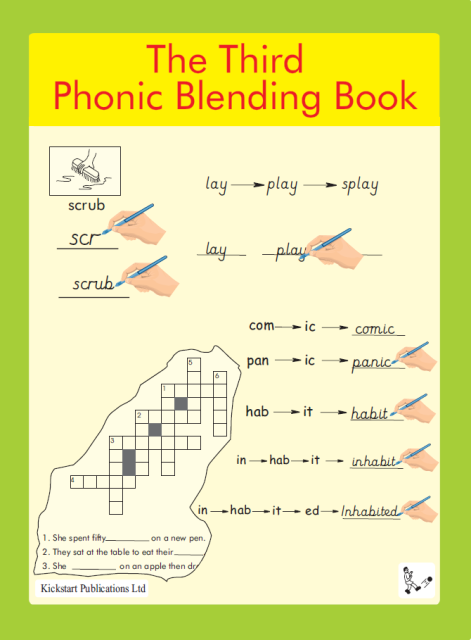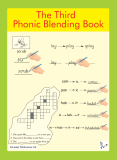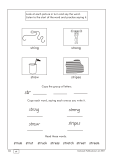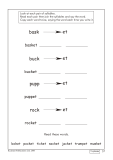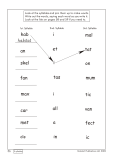Third Phonic Blending Book
SKU:
978-1-913884-26-0
€19.95
€19.95
Unavailable
per item
The Third Phonic Blending Book is designed to follow the First and Second Phonic Blending Books.
The worksheets cover initial consonant clusters and ‘dge’, ‘nce’, ‘ntch’ and ‘tch’ endings, initial ‘gu’ with silent ‘u’, and multi-syllabic words.
Consonant clusters and endings
It is inevitable that many of the words having consonant clusters will include phonemes with vowel digraphs or dipthongs which, in the hierarchy of phonic skills, are more difficult than consonant clusters. Where possible, pictures are provided as cues for when the pupil starts to learn the consonant cluster. The aim of the worksheets in this section is for the pupil to match the letters in the cluster with the corresponding sounds. The multi-sensory activities develop this skill and provide opportunities for consolidation.
It is important that, from the beginning, the pupil articulates the cluster as a continuous group of sounds, i.e.:
scr rather than s-c-r
When completing the worksheets, it is often helpful to encourage the use of joined script if the pupil’s writing skills are at the appropriate stage. The use of joined script improves the effectiveness of multi-sensory approaches and helps with the development of spelling skills.
‘gu’ with silent ‘u’
This phoneme can cause difficulties, especially when attempting to spell the words. When teaching this phonic skill it is always worth teaching the spelling of the words at the same time. With older pupils, it is often helpful to explain that the letter ‘g’ usually has a soft sound when followed by the vowels ‘e’ and ‘i’, and that the letter ‘u’ is placed between the ‘g’ and the vowel to give the ‘g’ a hard sound.
Multi-syllabic words
All of the words used in this section of the resource consist entirely of syllables with short vowel sounds. This means that the only skill required by the pupil is reading c-v-c syllables. It may be necessary to remind pupils that all syllables have short vowel sounds, particularly with syllables ‘car’ or ‘par’. It is important that the pupil can say each syllable without letter-by-letter blending before combing syllables to read multi-syllabic word. If the pupil is still at the stage of blending c-v-c syllables, the process of reading multi-syllabic words may be too protracted to become effective as a word attack strategy.
The worksheets cover initial consonant clusters and ‘dge’, ‘nce’, ‘ntch’ and ‘tch’ endings, initial ‘gu’ with silent ‘u’, and multi-syllabic words.
Consonant clusters and endings
It is inevitable that many of the words having consonant clusters will include phonemes with vowel digraphs or dipthongs which, in the hierarchy of phonic skills, are more difficult than consonant clusters. Where possible, pictures are provided as cues for when the pupil starts to learn the consonant cluster. The aim of the worksheets in this section is for the pupil to match the letters in the cluster with the corresponding sounds. The multi-sensory activities develop this skill and provide opportunities for consolidation.
It is important that, from the beginning, the pupil articulates the cluster as a continuous group of sounds, i.e.:
scr rather than s-c-r
When completing the worksheets, it is often helpful to encourage the use of joined script if the pupil’s writing skills are at the appropriate stage. The use of joined script improves the effectiveness of multi-sensory approaches and helps with the development of spelling skills.
‘gu’ with silent ‘u’
This phoneme can cause difficulties, especially when attempting to spell the words. When teaching this phonic skill it is always worth teaching the spelling of the words at the same time. With older pupils, it is often helpful to explain that the letter ‘g’ usually has a soft sound when followed by the vowels ‘e’ and ‘i’, and that the letter ‘u’ is placed between the ‘g’ and the vowel to give the ‘g’ a hard sound.
Multi-syllabic words
All of the words used in this section of the resource consist entirely of syllables with short vowel sounds. This means that the only skill required by the pupil is reading c-v-c syllables. It may be necessary to remind pupils that all syllables have short vowel sounds, particularly with syllables ‘car’ or ‘par’. It is important that the pupil can say each syllable without letter-by-letter blending before combing syllables to read multi-syllabic word. If the pupil is still at the stage of blending c-v-c syllables, the process of reading multi-syllabic words may be too protracted to become effective as a word attack strategy.

